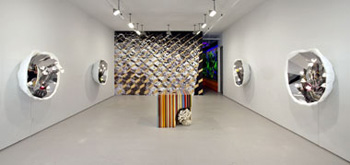Two exhibitions
dal 24/2/2006 al 31/3/2006
Segnalato da
24/2/2006
Two exhibitions
Elizabeth Dee Gallery, New York
Green Winter. Virgil Marti covers the walls and ceiling of the Main Gallery with plaster sculptures of large flowers and other motifs. In Gallery 2, Helen Sadler presents a suite of new paintings, executed in her customary egg tempera on wood. Using the medium of an early Renaissance master, she makes small panels that depict moments of intense experience.

Virgil Marti: Green Winter. Helen Sadler: New works
Virgil Marti covers the walls and ceiling of the Main Gallery with plaster
sculptures of large flowers and other motifs. Half-chrome mirrored bulbs set in the
reliefs reposition the decorative as functional, at the same time they cast a light
back onto the sculptures that reveals them to be composed entirely of human bones.
Skulls, scapulae, clavicles, coccyxes, patellae, femurs, tibiae, and other bones
cast in plaster make up the flora, fauna, and snowflakes of the design. The initial
impression of an all-over room treatment yields to the slightly macabre knowledge
that the decorations comprise intricate patterns formed of the repeated parts of
reconfigured skeletons, punctuated by the artist’s signature translucent flowers
in brightly colored resin.
Green Winter marks a progression from Marti’s prior essays in cast resin antler
chandeliers and white plastic tortoise shells with lighted, flowering cacti. As in
his previous rooms, the artist draws inspiration for this installation from
disparate sources in art and cultural history. Seventeenth and eighteenth-century
plasterwork represents the obvious origin of the wall and ceiling reliefs, but it is
conflated with the coeval, yet seemingly incongruous, decorative scheme of the bone
chapels of Europe, such as that of the Capuchins in Rome, in which all manner of
architectural embellishment was made from the skeletons of dead monks. To
complicate matters further, the artist derives the motif of towering vegetation from
the drawings of Henry Darger, whose collage aesthetic produced scenes of small girls
dwarfed by huge garden flowers. The human bones might suggest affinities with the
gothic or a heavy metal taste for allusions to death, but the outlandish scale of
the oversized blossoms, the evocations of the rococo in the confectionary
white-on-white, and the drollery of the ornamental conceit, point to a more subtle
and complex intention.
The work’s title, Green Winter, contracts a saying of the artist’s grandmother,
which foretold illness from too warm a winter. In the current climate, both
meteorological and geopolitical, the old-wife’s adage suggests a more dire
prediction. Marti allows the faint echoes of a future forewarned to color his
illuminated environment and create a walk-in memento mori, in which the faux gaiety
of the imagery cannot quite offset the fact that we are all destined for the bone
heap.
Green Winter is Virgil Marti’s second exhibition at Elizabeth Dee. His seminal
Grow Room was featured in the 2004 Whitney Biennial and is a promised gift to that
institution. The artist has been the subject of exhibitions at the Santa Monica
Museum of Art; the Institute of Contemporary Art, Philadelphia; Participant, Inc.;
the Pennsylvania Academy of the Fine Arts; and Thread Waxing Space. He lives and
works in Philadelphia.
In Gallery 2, Helen Sadler presents a suite of new paintings, executed in her
customary egg tempera on wood. Using the medium of an early Renaissance master, she
makes small panels that depict moments of intense experience. Appropriating images
from film and video, the artist captures people, young women in particular, at
instants of ecstatic abandon, profound grief, or emotional crisis. She chooses
figures from events in recent history or from the era of her childhood, the 1960s
and ‘70s. The subjects of her recent works range from close-ups of fans at rock
concerts—Woodstock in 1969 and Wattstax in 1972—to news footage of the arrests
of the young female accomplices of Charles Manson, to mourners at the funeral of
Pope John Paul II. Painting with a delicate looseness and transparent washes of
color, as if egg tempera were watercolor, Sadler catalogues nuances of the
ineffable, played across the faces of her subjects. Despite their diminutive scale,
her panels compel our attention with their concentrated passion.
This is Sadler’s first one-person exhibition at Elizabeth Dee. She was included
in The Sublime Is (Still) Now at the gallery in 2004, and in Ciao! Manhattan: Recent
Painting from New York at Perugi Artecontemporanea in Padua that same year, and in
Girls on Film at Tyler School of Art in Philadelphia in 2003. Solo shows of her
work have been held at Team in New York and at Biagiotti in Florence, Italy. The
artist lives and works in New York.
A reception for the artists
will be held on Saturday, February 25th, from six to eight pm.
Elizabeth Dee Gallery
545 W 20th Street - New York



